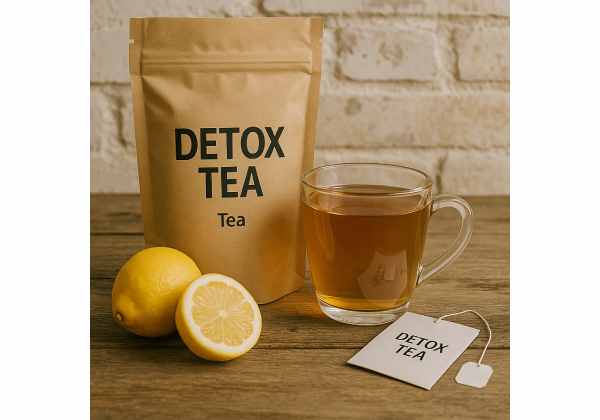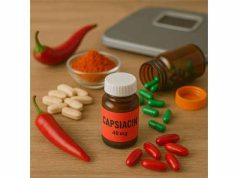
Detox teas and laxative cleanses promise a flatter stomach in days. The scale often does drop—but mostly from water, stool, and glycogen, not body fat. Rapid losses rebound as soon as you rehydrate and eat normally, and frequent use carries real risks for digestion, electrolytes, and your relationship with food. This guide explains what these products actually do, why “weight” falls quickly, who is most vulnerable to side effects, and how to get a leaner look safely. If you are comparing nonprescription supplements with clinician-guided options, start with our plain explanation of medical and supplement options for weight management so you can place detox teas in context.
Table of Contents
- Do detox teas and laxative cleanses work?
- Why the scale drops then rebounds
- Ingredients: what they actually do
- Common mistakes and red flags
- Safety risks and who should avoid
- Evidence summary and realistic outcomes
- Safer ways to feel lighter and lose fat
- Frequently asked questions
Do detox teas and laxative cleanses work?
Short answer: They shift scale weight fast, but they do not reduce body fat. Most of the drop comes from losing water, digestive contents, and stored carbohydrate (glycogen). The effect is temporary, and repeated use can create a cycle of dehydration, rebound water retention, and irregular bowel habits.
What “works” and what does not
- Works for the scale:
- Stool mass: If you normally carry ~0.2–0.5 kg of stool and fluid in the gut, forced bowel movements make the number fall.
- Water loss: Diuretic herbs and reduced sodium intake make you shed water.
- Glycogen depletion: Eating far fewer carbs for a day or two plus sweating can cost another kilo or so—mostly water attached to glycogen.
- Does not work for fat loss:
- Laxatives act in the large intestine, after most calories are absorbed in the small intestine. You are not “flushing out” the calories from your last meal.
- Diuretics shift water between compartments; they do not increase fat oxidation.
Visible changes
- You may look less puffy for 24–48 hours if you started bloated. That can feel motivating, but it is not the same as reducing fat.
- Many people notice a quick rebound, sometimes with greater bloating, once they resume normal eating or rehydrate.
When does it backfire?
Using these products before events (weddings, weigh-ins, photo shoots) often leads to cramping, urgent bathroom trips, and fatigue—not the calm confidence you hoped for.
If you are still setting the foundation
Lasting fat loss comes from consistent habits—protein intake, fiber, movement, sleep, and a moderate calorie deficit. For a clear, step-wise plan, review our core guidance on safe weight loss fundamentals before considering any “detox.”
Why the scale drops then rebounds
Detox teas and laxative cleanses create a fluid shift and empty your gut. Understanding those levers helps you predict the rebound—and avoid misreading the scale.
Glycogen and water coupling
Your muscles and liver store glycogen as a ready fuel. Each gram of glycogen binds several grams of water. Cut carbs hard for a couple of days and you will shed 1–2 kg of combined glycogen and water—without touching body fat. When you eat normally again, glycogen and water are restored, and the scale climbs.
Sodium and water balance
Many “cleanse” plans also restrict salt. Lower sodium reduces extracellular water and can deflate the puffy look. Reintroduce salty foods and the water returns. This is hydration regulation, not fat loss.
Stool mass and transit
Laxatives accelerate transit or draw water into the colon, producing larger, softer stools. The temporary scale drop reflects less material in the gut, not less fat on the body.
Hormonal and stress effects
Poor sleep, high caffeine, and stress hormones (common during extreme cleanses) can raise aldosterone, a hormone that encourages water retention. That is why some people see a larger rebound than the initial drop once they “come off” a cleanse.
Bloating vs. adiposity
Bloating changes hour to hour; body fat changes week to week. Track both waist circumference (at the navel) and a weekly weight average to separate cosmetic water shifts from true progress. If the goal is appetite control and steadier digestion, soluble fiber is a safer, evidence-based ally; see practical picks in our review of glucomannan and psyllium.
Ingredients: what they actually do
Not all detox products work the same way. Here is what common ingredients actually do—minus the marketing.
Stimulant laxatives (senna, cascara, aloe)
- Mechanism: Irritate the intestinal lining and increase contractions.
- What you feel: Cramps, urgency, and loose stools.
- Risk with frequent use: Dependence (the colon becomes less responsive without them), electrolyte losses, worsening constipation between doses.
Osmotic laxatives (magnesium citrate, magnesium sulfate)
- Mechanism: Draw water into the colon.
- What you feel: Bloating, gurgling, then watery stools.
- Risks: Dehydration and low sodium/potassium if overused; high doses can be unsafe in kidney disease.
Bulking agents (senna blended with psyllium, glucomannan)
- Mechanism: Fiber holds water, increases stool size, and can improve regularity when used alone and at proper doses.
- Caveat: Pairing bulk fiber with stimulant herbs may mask dependence. Stand-alone fiber is the safer approach for regularity and appetite.
Diuretic herbs (dandelion, uva ursi, juniper)
- Mechanism: Increase urine production.
- Outcome: Lower scale weight for a day; no effect on fat tissue.
- Caution: Combine with sweating or low sodium and you risk lightheadedness.
Caffeine, green tea extracts, yerba mate
- Mechanism: Stimulate the nervous system; can modestly raise alertness and exercise output.
- Reality check: When tucked into detox blends, doses are usually uncertain and stacked with laxatives. If you use caffeine for training, use it deliberately—see dosing and timing in our guide to caffeine for weight loss and performance.
“Detox” botanicals (milk thistle, ginger, burdock, nettle)
- Mechanism: Often included for branding rather than clear, clinically meaningful effects on fat loss or toxin removal. The liver already detoxifies continuously via enzymes; tea does not “turn on” detox pathways in a way that melts fat.
Label translation tips
- “Proprietary blend” = you do not know the dose.
- “Night cleanse/day cleanse” = stimulants separated from laxatives to maintain round-the-clock effects.
- “Debloat” often means diuretic or laxative, not a fix for the cause of bloating (diet, fiber mismatch, IBS, or hormones).
Common mistakes and red flags
Using teas as a “reset” every weekend
- Why it backfires: You drain water during the cleanse, then rebound retain after salty meals. The weekly average does not change, and you feel more puffy by Monday.
Stacking diuretics and laxatives
- Why it backfires: The combination pushes electrolytes (sodium, potassium, magnesium) out faster. Side effects creep in: fatigue, headaches, muscle cramps, palpitations.
Detoxing before a hard workout or competition
- Why it backfires: Dehydration plus GI urgency sabotages performance and increases injury risk.
Ignoring drug interactions
- Why it backfires: Faster transit can alter absorption of certain medications (e.g., oral contraceptives, thyroid meds). High magnesium may conflict with some antibiotics. If you need regular, reliable dosing, do not add a purge.
Chasing “flatness” instead of causes of bloat
- Smarter approach: Identify patterns—large late meals, low fiber, high sugar alcohols, fast eating, or IBS triggers. Fixing the inputs beats treating symptoms with laxatives.
Buying blends with hidden doses
- Fix: Choose products with clear amounts, or better yet, skip detox blends. If you are comparing supplements of any kind, learn quick label checks in how to read supplement labels so marketing terms do not mislead you.
Mistaking constipation for “toxins”
- Fix: Address basics: adequate fluids, 25–35 g fiber/day, daily walking, consistent meal timing, and (when needed) stand-alone, non-stimulant fiber. Escalate to medical evaluation for persistent symptoms, bleeding, or pain.
Safety risks and who should avoid
Occasional tea is one thing; habitual use is another. Here are the real risks and the groups who should avoid detox/laxative regimens.
Short-term risks (even with a single cleanse)
- Dehydration and dizziness—worse in heat or with exercise.
- Electrolyte imbalances (low potassium, low sodium) causing fatigue, cramps, or palpitations.
- GI distress—cramps, urgency, diarrhea, rectal irritation.
- Sleep disruption from nighttime “cleanse” blends.
Medium- to long-term risks (with frequent use)
- Laxative dependence: The colon becomes sluggish without stimulants; constipation worsens between doses.
- Worsening IBS, hemorrhoids, fissures from frequent loose stools.
- Kidney stress from dehydration, high oxalate herb mixes, or high magnesium in those with impaired renal function.
- Disordered eating patterns: Cleanses can reinforce binge–purge cycles and anxiety around normal meals.
Who should avoid entirely or seek medical advice first
- Pregnant or breastfeeding individuals.
- People with kidney disease, heart rhythm issues, or uncontrolled hypertension.
- Anyone on drugs affected by fluid/electrolyte shifts (e.g., diuretics, lithium, certain heart meds).
- Those with a history of eating disorders or active GI disease (IBD, severe IBS).
- Children and adolescents.
Quality concerns
- Herbal products vary widely in potency and contaminants. If you choose any supplement, look for independent testing (e.g., USP, NSF, Informed Choice) and avoid proprietary blends with undisclosed doses; see why these seals matter in our explainer on independent testing.
Stop rules—seek care now if you have
- Persistent vomiting, blood in stool, fever, severe abdominal pain, fainting, chest pain, or no urination for 8+ hours. These are not cleanse side effects to ride out.
Evidence summary and realistic outcomes
What the research shows
- Fat loss: There is no robust clinical evidence that detox teas or laxative cleanses increase fat oxidation or cause sustained fat loss compared with standard calorie deficits. Laxatives act after calories are absorbed.
- Weight loss: Trials that show quick losses mainly reflect fluid and gut content shifts. Without ongoing diet changes, weight returns within days.
- Side effects: Documented adverse events include electrolyte disturbances, dehydration, medication interactions, and GI injury with stimulant laxatives—especially with chronic use.
Why the marketing sounds convincing
- Before-and-after photos often compare bloated evening photos with dehydrated morning photos.
- Testimonials highlight the first 48 hours, not the two-week follow-up.
- “Natural” is used as a health halo—even when the plant (senna) is a pharmacologic stimulant.
What realistic success looks like
- A sustainable plan yields 0.5–1.0% of body weight lost per week on average, with appetite kept in check and energy preserved.
- For appetite and calorie control, interventions with evidence—protein distribution, high-fiber meals, resistance training, and consistent sleep—beat teas. Medical therapies can help specific patients; see an overview of when medications fit in weight-loss medications explained.
Bottom line
If your goal is to look leaner and feel lighter, chasing rapid water loss is a dead end. Build predictable digestion and steady fat loss instead. Use the next section as a blueprint.
Safer ways to feel lighter and lose fat
You can reduce bloat and lose fat—without purging. Use this two-track approach: quick fixes for comfort, and a weekly rhythm for real change.
Same-day comfort (reduce bloat without cleanses)
- Meal structure: Three meals, minimal grazing. Slow down and chew thoroughly.
- Fiber swap: Replace “rough” insoluble fiber at dinner (huge raw salads) with soluble sources earlier in the day (oats, beans, psyllium).
- Salt timing: Keep daily sodium consistent. If you have a salty meal, drink water and walk for 10–15 minutes afterwards.
- Gas formers: For sensitive guts, dial back polyols (sorbitol/xylitol), very high-FODMAP beans/onions, and carbonated drinks for 24 hours.
The weekly rhythm (actual fat loss)
- Calorie target: Use a moderate deficit (e.g., 300–500 kcal/day), not extreme cuts.
- Protein anchor: Aim for 1.2–1.6 g/kg/day split across 3–4 meals.
- Fiber target: 25–35 g/day from plants; add psyllium if your meals fall short.
- Training: Two to three full-body resistance sessions plus 6,000–10,000 steps daily.
- Sleep: 7–9 hours. Poor sleep spikes hunger and water retention.
- Checkpoints: Track waist and a weekly weight average. Ignore single-day noise.
If you want additional support
- Choose stand-alone products with clear dosing (e.g., psyllium husk).
- Avoid blends that pair stimulants with laxatives.
- Curious about lifestyle plus medication? Review expectations and side effects in our plain-English overview of GLP-1 options and discuss with your clinician if you qualify.
A note on event prep
For a one-day “flatter” look: sleep well, keep sodium steady (not zero), avoid very large late meals, and stick with foods you digest predictably. Do not purge.
Frequently asked questions
Do detox teas burn fat?
No. They empty the gut and shift water, which lowers the scale temporarily. Fat loss requires a calorie deficit over time. Teas and laxatives do not increase fat oxidation and may worsen appetite and energy, making real progress harder.
How much of the first-week loss is water?
Often the majority. Cutting carbs plus diuretics can drop 1–2 kg of glycogen-bound water, and laxatives empty stool. That is why weight returns quickly when you resume normal eating and hydration.
Are stimulant laxatives safe if used once?
A single dose is unlikely to harm a healthy adult, but cramps, urgency, dehydration, and medication timing issues are common. People with kidney disease, heart rhythm issues, GI disease, or pregnancy should avoid them entirely.
Can detox teas help with constipation?
Not as a routine. Stimulants can worsen constipation between uses by making the colon less responsive. For regularity, prioritize fluids, soluble fiber, walking, and consistent meal timing. Seek medical care for persistent symptoms or red flags.
Why do I look less bloated the next morning?
Lower sodium intake, less food volume, glycogen depletion, and stool emptying all reduce abdominal fullness. The cosmetic effect is temporary; it does not reflect fat loss. Rehydrate and eat normally to avoid rebound bloat and fatigue.
What should I use instead of a cleanse before an event?
Sleep well, keep sodium intake steady, avoid very large late meals, choose familiar foods you digest easily, and take a short evening walk. If fiber tends to bloat you at night, shift more fiber to breakfast and lunch.
References
- American Gastroenterological Association-American College of Gastroenterology Clinical Practice Guideline: Pharmacological Management of Chronic Idiopathic Constipation – PMC 2023 (Guideline)
- Review article: do stimulant laxatives damage the gut? A critical analysis of current knowledge – PMC 2024 (Systematic Review)
- Laxatives – StatPearls – NCBI Bookshelf 2024 (Review)
- Hydration, Hyperthermia, Glycogen, and Recovery: Crucial Factors in Exercise Performance—A Systematic Review and Meta-Analysis – PMC 2023 (Systematic Review/Meta-analysis)
- Physiology, Nutrient Absorption – StatPearls – NCBI Bookshelf 2023 (Review)
Disclaimer
This article is educational and not a substitute for professional medical advice, diagnosis, or treatment. Do not start, stop, or combine supplements or laxatives without discussing your health history and medications with a qualified clinician. Seek urgent care for severe abdominal pain, blood in stool, fainting, chest pain, or signs of dehydration.
Share and follow
If this guide helped you separate quick scale tricks from real fat loss, consider sharing it with someone who is tempted by “detox” claims. For practical, evidence-based updates on weight management, follow us on your preferred social platforms—Facebook, X, Instagram, or LinkedIn.










